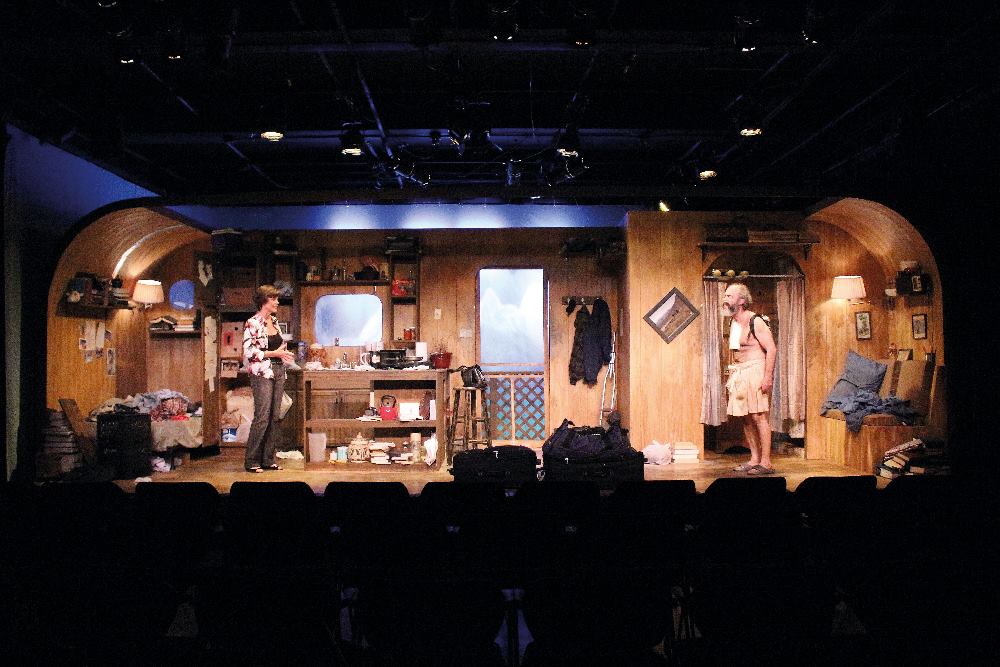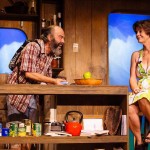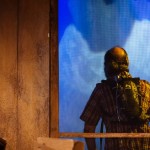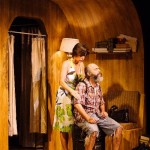Each month, American Theatre goes behind the scenes of the design process of one particular production, getting into the heads of the creative team.
In Sharr White’s Annapurna, Ulysses and his estranged wife Emma reunite in a dingy trailer in Colorado after 20 years apart. For the play’s production at Tampa, Fla.’s Jobsite Theater, the design team’s challenge was to pack the trailer, and the mountains around, into inside a 99-seat black box with a low ceiling and no loading dock.

David Jenkins, CO-DIRECTION AND SOUND DESIGN: Sharr White described the set as this bisected trailer that is just a total shithole, and is almost dwarfed by this mountain range. That visual is really compelling—the idea of this disgusting, dirty, claustrophobic, tiny little trailer, set against the giant majestic mountainscape. Our space is very small—it’s basically 11 feet floor-to-grid in height and 30 feet wide from wall to wall. We don’t have a loading dock or a loading door. Everything essentially needed to be brought in in 4×8 chunks, otherwise we couldn’t get it through the door. And then it had to be assembled in the room.
The other challenge became how to do the backdrop, because we don’t have a lot of height. You want the idea of these two people trapped in this little space. We went with a sky-blue cyc and glass gobos that could give the appearance of mountains. I’m really impressed that we fit it in the space, actually, because we were like, “Oh, it’s just a little Airstream. It’s not going to be that big a deal.” And once we got it in there, we were like, “Oh my God, we’re practically going wall-to-wall with the set!”
An Easter egg thing that I thought was fun for us was (because the play deals with family and death and it’s a comedy) that we all put personal effects on the set that belonged to someone we’ve lost. In the picture, there’s a blue coat hanging by the door that belonged to my co-director’s grandfather who just passed away. On the shelf centerstage, there’s a baseball glove and a photograph right next to it—that’s my father’s baseball glove. It was a fun thing that gave the set some good luck.

Brian M. Smallheer, SCENIC AND LIGHTING DESIGN: This is one of the shows where the devil is in the details. It’s very much about getting into Ulysses’s mind and trying to figure out who he is. Ulysses had just gone through this radical lung-reduction surgery. So he has a scar on his chest. When he drops something on the ground, he doesn’t bother picking it up because it causes him horrible pain. We were really trying to show that he doesn’t clean up after himself—a lot of the set dressing was books. I saw the character as a book reader—he’s a poet, and he’s also spent the past 20 years writing letters to his ex-wife. He actually has five years’ worth of letters under his bed. We normally worry about making things look so nice; it was a refreshing change of pace to bang stuff up. It’s almost easier—you make it look nice and then you just do brown washes and gray washes and add layers and layers of filth.
The set also had to have working sinks and working electricity because at the top of the show, Ulysses is grilling up sausage. Sharr White actually says in the set direction that it’s important that we try to have the sausage frying at the top of the show; Ulysses likes the smell. The scent adds another layer to the design.
Annapurna by Sharr White played at Jobsite Theater in Tampa, Fla. May 1–24. It featured co-direction from Summer Bohnenkamp and David M. Jenkins, light design from Kaylin Gess, sound design from Jenkins, props and costume assistance by Roz Potenza, scenic and lighting design by Brian M. Smallheer, costume design by Beth Tepe-Robertson, stage management by Matthew Ray, and assistant stage management by Tiffany Daiber.







